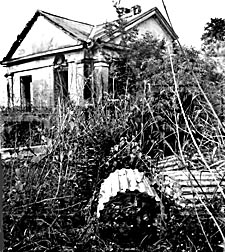ART REVIEW
Art and Life in Louisiana: Elemore Morgan Sr. and Elemore Morgan Jr.
Louisiana Story: A Photographic Journey through the Robert Flaherty Film
by: Eric Bookhardt
Elemore Morgan Sr.’s Woodlawn Remains, 1949, photograph of an abandoned plantation structure suggests ancient ruins moldering amid cane fields
One thing about the Ogden — it’s not like other museums, at least not entirely.

Elemore Morgan Sr.'s Woodlawn Remains, 1949, photograph of an abandoned plantation structure suggests ancient ruins moldering amid cane fields
Sure, the art world is arranged according to a star system made up of big names and local and regional favorites, and while the Ogden necessarily focuses on some of the most prominent luminaries associated with the South, it also tries to put more emphasis on the context, the connective tissues that tie together the art of this region. Some examples of this can be seen in their current shows exploring the work of the late photographer Elemore Morgan and his son, Elemore Morgan Jr., the well-known painter.
The junior Morgan’s colorful Plein Air landscape paintings of the prairies of southwest Louisiana will be the more familiar to local art buffs. Routinely featured at the Arthur Roger Gallery, and instantly recognizable for their luminous warm tones and spontaneous, Zenlike brushstrokes, they are popular with a wide array of collectors. What sets this Ogden show apart is its retrospective inclusion of a lot of earlier work going back to his days at Oxford, where he studied art after serving in the Korean War. His 1956 Seated Nude is a coolly contemplative tableau starring a big pink naked lady on a sofa. Her not quite pendulous breasts hang not quite to her arm as it crosses the cool, salmon-tinged flesh of her thighs. Her eyes are not quite closed, and the whole scene is charged with the sort of detached psychological electricity that whispers: “Lucien Freud was here.” While it’s unlikely that the British master of psychological portraiture really was there, what we’re seeing may reflect some of the same cultural quirks that influenced both artists. But look again, and instead of Freud’s meticulously mottled flesh tones, we see Morgan’s animated brush strokes starting to ramble off on their own in a kind of wayward Cajun two-step on the canvas.
By the 1970s, Morgan had evolved into the colorfully expansive style he’s known for today, and on his return to England in 1995 he produced works such as Battersea Power Station, London, in which the famous power plant was rendered with a warm, luminous exuberance that feels fairly convincing despite being closer to Tuscany, or even Terrebonne Parish, in tone. In fact, the light is quite similar to his From the Porch, 1999, landscape depicting the emerald and salmon glow of the fields behind his home outside Lafayette as the sun glides gently down the cerulean blue dome of the Cajun sky. For Morgan, the dance of warm light over the humid landscape is enough.
The importance of the land and the light are also felt in the work of his father, Elemore Morgan Sr., an acclaimed industrial photographer whose more personal work falls somewhere between our native Louisiana romantic, Clarence John Laughlin, and the great American modernists such as Edward Weston. In fact, his cool, clear precision recalls Weston’s photographs of Louisiana’s plantation country, as well as the work of some of the great WPA photographers. But Woodlawn Remains, 1949, depicting the fallen fluted columns and Greek templelike form of a plantation outbuilding, exudes the romantic, ruinous aura of an ancient empire moldering amid the cane fields.
Although ruinous plantations such as this and his spectacular Trudeau House Near Lutcher, 1946, reveal Morgan Sr. at his formal best, his human empathy shines in images such as Men Playing Bouree in Back of Truck, Point A La Hache, 1948, and in Brusly St. Martin, 1949, a bayou scene that would fit in seamlessly among the movie stills from Robert Flaherty’s 1948 film classic, Louisiana Story, on view nearby.
In this last, and arguably best, of the great documentaries that followed in the wake of his 1922 landmark, Nanook of the North, Flaherty lovingly depicts the haunting, primitive beauty of Acadiana during the early years of its fitful romance with the oil industry. And if its tone of benign coexistence doesn’t quite hold water in retrospect, its reputation as a masterpiece remains — even the stills convey something of the film”s poetry, its evocation of the lost innocence of that place at the outset of its long, halting embrace of modernity.
